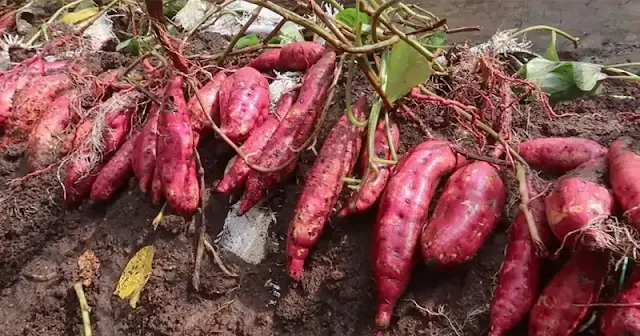Sweet potatoes are a delicious and nutritious addition to your home garden. They are easy to grow and offer a bountiful harvest, making them an ideal choice for both novice and experienced gardeners. If you have limited space or poor soil conditions, growing sweet potatoes in soil bags is a fantastic solution. In this comprehensive guide, we will walk you through the step-by-step process of growing sweet potatoes in soil bags.
Materials Needed:
Before you begin, gather the following materials:
- Sweet potato slips (young, rooted plants)
- Soil bags (or large grow bags)
- High-quality potting soil or a mix of compost and garden soil
- Watering can or garden hose with a gentle spray nozzle
- Fertilizer suitable for root vegetables
- Garden trowel or hand spade
- Stakes or trellises (optional)
- Mulch (straw or leaves)
Step 1: Choose a Suitable Location
Select a sunny location in your garden where the sweet potatoes will receive at least 6-8 hours of sunlight daily. Ensure the spot has good drainage to prevent waterlogging, as sweet potatoes dislike soggy soil.
Step 2: Prepare the Soil Bags
If you’re using commercial soil bags or grow bags, fill them with a high-quality potting mix, leaving a few inches of space at the top. Alternatively, you can make your own mix using equal parts compost and garden soil. Sweet potatoes thrive in loose, well-draining soil, so make sure your mix is well-aerated.
Step 3: Plant Sweet Potato Slips
Sweet potato slips are young, rooted plants that you can purchase from a nursery or create from sweet potatoes at home. Plant the slips about 4-6 inches deep in the soil bags, spacing them around 12-18 inches apart. Place each slip vertically with the roots facing downward and the leafy part above the soil surface.
Step 4: Watering
Sweet potatoes need consistent moisture, so water them regularly to keep the soil evenly moist but not waterlogged. It’s advisable to water them early in the morning to allow the leaves to dry out during the day, reducing the risk of fungal diseases.
Step 5: Fertilizing
Fertilize your sweet potatoes with a balanced, slow-release fertilizer. Apply it according to the package instructions, usually a few weeks after planting and then periodically throughout the growing season. Be cautious not to over-fertilize, as this can lead to excessive foliage growth and smaller tubers.
Step 6: Support and Trellising (Optional)
If you have limited garden space or want to encourage larger sweet potatoes, consider using stakes or trellises. You can gently tie the vines to the supports as they grow, which will also make harvesting easier.
Step 7: Mulch
To help retain soil moisture and suppress weeds, apply a layer of mulch around your sweet potato plants. Suitable mulch materials include straw, leaves, or even black plastic. Ensure that the mulch doesn’t come into direct contact with the stems to prevent rot.
Step 8: Harvesting
Sweet potatoes are usually ready for harvesting around 100-120 days after planting, depending on the variety and growing conditions. Carefully dig around the base of the plant and gently lift the tubers from the soil. Be cautious not to damage them during the harvesting process.
Step 9: Curing and Storing
After harvesting, sweet potatoes need to be cured to develop their flavor and heal minor injuries. Place them in a warm, humid place (80-90°F or 27-32°C) for about 10-14 days. After curing, store your sweet potatoes in a cool, dark place with proper ventilation to extend their shelf life.
Q1: What are some advantages of growing sweet potatoes in soil bags, as mentioned in the article?
A: Growing sweet potatoes in soil bags offers several advantages, including ease of cultivation, suitability for novice and experienced gardeners, and the ability to produce a bountiful harvest. It's also an excellent solution for those with limited garden space or poor soil conditions.
Q2: What is the recommended depth for planting sweet potato slips in soil bags, and how far apart should they be spaced?
A: It is recommended to plant sweet potato slips about 4-6 inches deep in the soil bags. They should be spaced around 12-18 inches apart to allow for proper growth and development.
Q3: Why is it important to water sweet potatoes early in the morning, according to the article?
A: Watering sweet potatoes early in the morning is advised because it allows the leaves to dry out during the day. This practice reduces the risk of fungal diseases, ensuring the health of the plants.
Q4: How can gardeners extend the shelf life of harvested sweet potatoes, as explained in the article's last step?
A: To extend the shelf life of harvested sweet potatoes, they need to be cured. This involves placing the sweet potatoes in a warm, humid place (around 80-90°F or 27-32°C) for about 10-14 days. After curing, the sweet potatoes should be stored in a cool, dark place with proper ventilation.
Growing sweet potatoes in soil bags is an excellent way to enjoy this nutritious and tasty root vegetable, even in small spaces or less-than-ideal soil conditions. With the right materials and care, you can successfully cultivate your own sweet potatoes at home. Follow this step-by-step guide, and you’ll be enjoying your homegrown sweet potatoes in no time. Happy gardening!

